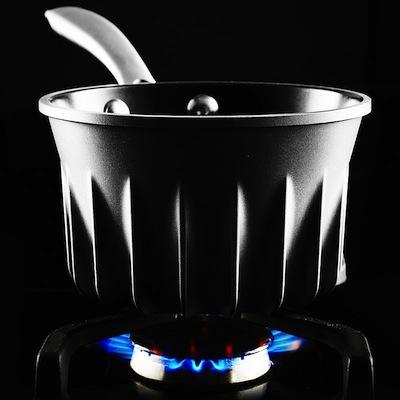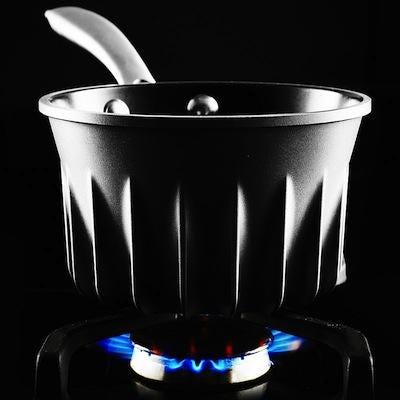Rocket Scientist Designs Cookware Based on Jet Engines
August 13, 2014

No, you don't have to be a rocket scientist to design cookware, but it does help. Just ask Dr. Thomas Povey, the Oxford rocket scientist behind the Flare pan -- the cookware that jet engine technology designed. The line of pots and pans has already won an award for its small carbon footprint. Chefs are hailing Flare for its ability to cook any meal at an even temperature throughout. Move over Martha Stewart, NASA's got this one.
As the story goes, Povey was on a camping trip and quickly became irritated at how long it was taking him to boil water. The experienced mountaineer was also frustrated with how much energy was being wasted. So, he did what any rocket scientist would do -- redesign a new pot that would heat up faster and with greater fuel efficiency.

When you first see a Flare pot or pan, you might think, "What is so special about this?" But the ridged cookware actually utilizes some of the most cutting-edge jet engine technology, called FIN-X technology.
Povey specializes in designing cooling systems for rocket and jet engines that reach extremely high temperatures. He has said that the problem with traditional cooking is the amount of heat that's lost when it travels up the sides of the pan. He said it's very similar to what happens when heating jet engines. They were designed with a similar shape.
The Flare pans may look foreign, but they're actually aerodynamic and feature ridges along the sides and bottom of the pans, so that the rising heat continues to work toward heating the contents of the pot. The result is a pot that is 40% more fuel efficient, has a smaller carbon footprint, and keeps all the food at an even temperature.
The Flare line of cookware was designed for gas burners. It can even handle baking at temperatures up to 400°F. The pots and pans are made from nonstick-coated cast aluminum with stainless-steel handles and are of conventional shape. Since the pot heats up more quickly, it wastes less energy, earning it the 2014 Hawley Award for "the most outstanding engineering innovation that delivers demonstrable benefit to the environment," from The Worshipful Company of Engineers. Why haven't we recruited rocket scientists to redesign the kitchen sooner?
The idea was originally meant to target the outdoor market, but Povey realized all makeshift chefs share the same problem with heating food, so Flare was born. In clinical trials with professional chefs, the study participants raved about the cookware's ability to keep an even cooking temperature throughout the pot, resulting in shorter cooking times, too. Shorter cooking times can surely help in a high-volume restaurant, and the energy efficiency will not only help the planet, but also our wallets.
The Flare line launched in Lakeland. Anyone looking for a complete set of rocket-inspired cookware should expect to cough up a bit over $400. While it isn't the cheapest line, it does greatly reduce energy consumption.
Related posts:
About the Author(s)
You May Also Like





